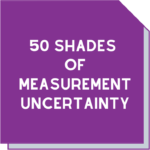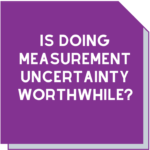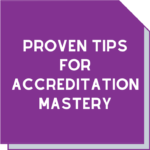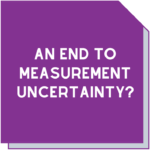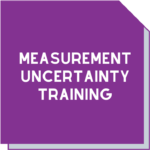5 TOP TIPS for presenting Measurement Uncertainty
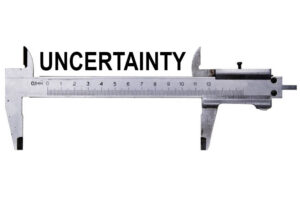
Eccentric business owners. Cantankerous managers. Agitated lab staff. Confused clients. As consultants, we’ve seen it all (well most of it anyway…).
However, by far the most consistent issue we’ve come across is confusion about measurement uncertainty (MU).
Often, a business will approach us after an accreditation body (AB) such as NATA has rejected their MU budget. Labs understand that it’s not the role of the AB to explain how to do their jobs. But after a series of observations, nonconformances and questions, labs often find themselves in a tangle that they can’t unravel.
That’s where we come in.
We’ve discovered that there are similar issues experienced by labs when it comes to measurement uncertainty. Often these issues are around the calculation process and data.
So here are our top 5 tips for easing your measurement uncertainty woes.
Tip 1: Consider all the factors
When you calculate your MU budget, don’t dismiss an uncertainty factor without having evidence that the factor is negligible. This applies whether the evidence is a result of your own experiments or from the published research of other scientists and labs.
This evidence needs to be presented to the AB. Remember, just because a value is under the allowed interval or is small, doesn’t mean that there is no uncertainty.
By having this evidence, you’ll demonstrate to the AB and the technical assessor that you understand the principles of MU and the method you’re using.
Tip 2: Document your measurement uncertainty process
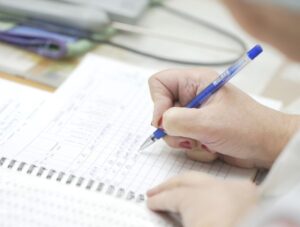 Following a recipe makes it more likely that your dish will turn out the way it’s supposed to.
Following a recipe makes it more likely that your dish will turn out the way it’s supposed to.
Like a recipe, it will help to prepare a document that describes the process you follow to calculate your uncertainty budget. The document should include both information on how any data was obtained and used and the calculation method itself.
This ensures your message is consistent not just for the AB but also with staff who are developing MU budgets.
This document will take time to prepare. However, this means that the technical assessor will have complete information about what you did. This will allow her to evaluate and provide meaningful feedback on your work.
That back-and-forth email messaging to an increasingly confused assessor will be a thing of the past!
Tip 3: Reference and validate your measurement uncertainty sources
Unlike reporters, revealing your sources when it comes to MU is strongly encouraged.
There are an increasing number of published documents describing how to calculate MU. Some examples of valid sources are industry journals, publications from professional societies, advice from industry experts and scientific papers. You should check the validity of the source. Wikipedia, while it can be a useful source of information, is not the best ‘go to’ place for information when it comes to dealing with an AB!
Be sure to confirm that the method you’re relying on applies to your area of testing.
Provide the reference document to the technical assessor if copyright allows for this. This part is critical, particularly if you’re working in a new or innovative area of science. If you’re using a known industry method for developing your uncertainty budget, don’t assume that everyone knows of its existence.
The reference document will allow your assessor to evaluate the technical validity of your uncertainty budget calculation.
Tip 4: Use spreadsheets effectively
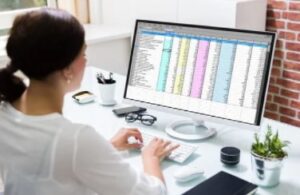 It makes good sense to use the tools at your disposal in the most efficient way possible.
It makes good sense to use the tools at your disposal in the most efficient way possible.
For example, let’s say you’re using an Excel spreadsheet to calculate your measurement uncertainty budget. Rather than inputting the values directly, use cell references in your formulas instead.
This will help the technical assessor easily track and understand your calculations and make the process smoother for them.
It will also help you. If you need to modify a value in your MU budget, you’ll only need to update one cell and click the save icon. The spreadsheet will do its magic and update all the calculations.
Tip 5: Define your origin
Data isn’t usually spun out of thin air*.
Name and indicate the origin of the values used for your MU calculation. Explain to the technical assessor the values in your calculation and where they came from.
Specify if a value came from a calibration or reference standard certificate, a scientific article, or a standard.
Again, this will assist the assessor to evaluate the technical validity of your MU budget.
*If it is, you’ll definitely need to get on top of this before applying for accreditation!
Final thoughts
Over the years we’ve found that MU gets a lot of blame for rejection from an AB.
While it may be the case that some assessors are more pedantic than others one thing is clear.
Getting MU right isn’t just about accreditation.
MU is an important tool for your business and for the people you provide results to, and a critical part of your system.
If you need help with MU, we’re right here for you!
We have extensive experience with supporting businesses through training courses and by examining MU budgets, testing processes and systems.
If you’d prefer to have your training done inhouse, contact Maree (0411 540 709, Diane (0402 012 781) or email info@masmanagementsystems.com.au to set up a confidential discussion.
Remember, you don’t have to do this alone!
Download the article 5 top tips for MU
Read our complete guide to learn more about ISO 17025.


